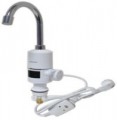The number of heating elements provided in the design of the water heater. In this case, it is the total number of elements that are taken into account, regardless of whether they belong to the same type or different ones: for example, 2 heat exchangers and 1 heating element are considered as 3 elements.
All gas models (see "Energy source") have only one heating element — this is quite enough for efficient operation. In
combined devices (see ibid.), on the contrary, there are several heating elements by definition (at least two — a heat exchanger and an electric one). In electric and indirect water heaters, the options may be different.
The meaning of several heaters of the same type is primarily to increase the heating efficiency. For example, in an instant (see "Type") electrical water heater, in this way, it is possible to increase the working length — the distance that water passes inside the device from inlet to outlet; by increasing the working length, the water is heated longer. In storage electric models, several heaters provide more uniform heating of the water, and in indirect ones, they allow more heat to be taken away. In addition, in indirect devices, heat exchangers can differ in the source of heating: for example, one can work from a heating boiler, the second from a solar collector.
Also, note that duplication of heating elements can also be used as protection against failures: if one of them
...fails, the heating efficiency decreases, but the device remains operational. However, this possibility is not available in all models with several heaters, its presence should be clarified separately.
